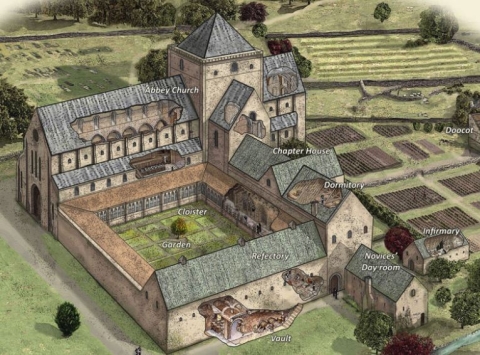Haddington’s Lost Abbey and its Place in Scotland's History Remembered

There was an interesting article recently in the Scottish local newspaper the East Lothian Courier. It was about the recent unveiling of an an information panel on the site where the Abbey of St Mary once existed. It is close to the River Tyne, between the town of Haddington (Scottish Gaelic: Baile Adainn) and the village of East Linton in East Lothian, Scotland (Scottish Gaelic: Lodainn an Ear, Alba). Nearby the Abbey Bridge and Abbey Mill farm are the only other clues that an abbey once stood next to the public footpath that goes by Hailes Castle. Other indications are some hidden dressed stones found in the ground or incorporated into later buildings.
Despite the lack of physical evidence the once proud abbey played an important part in the local area and in the national history of Scotland. It had ancient origins for it was founded in the 12th century by Ada de Warenne who was to become became the wife of Prince Henry, the son of David I of Scotland. The lands around Haddington were granted to her as part of her marriage settlement. She had seven children, two of them became kings of Scotland. Ada was very religious so in 1178, she founded a Cistercian Abbey here that was dedicated to the Virgin Mary.
Margaret Tudor (28 November 1489 – 18 October 1541), aged 13, daughter of Henry VII of England stayed at the Abbey in 1503 on her way to marry James IV of Scotland. Her son was James V (10 April 1512 – 14 December 1542) of Scotland and granddaughter Mary, Queen of Scots (8 December 1542 – 8 February 1587). Her great great grandson was James VI of Scotland, who became the first monarch to rule over both Scotland and England after the death of Elizabeth I.
On July 7th, 1548 a parliament was held at the Abbey. They were here to discuss the issue of Queen Mary I of Scotland's marriage to the French Dauphin, Francois (19 January 1544 – 5 December 1560). The Treaty of Haddington was agreed and Mary was to marry the heir to the French throne. Her great great grandfather Henry VIII of England was very angry, as he wanted Mary Queen of Scots, to marry his son Edward.
The Reformation was to finally seal the fate of the Abbey of St Mary at Haddington. The last prioress signed over the abbey in 1567. The ancient abbey fell into ruin after that and its stones used over the years for other buildings until nothing remained. Now Haddington’s History Society, after securing funding from Haddington and Lammermuir Area Partnership (HALAP), Archaeology Scotland and utilising their own funds, have erected an information panel covering the period 1158 to 1560 on the site where the abbey used to stand. Highlighting the remarkable story of a former historic abbey and its place in Scotland's history.
Image: Abbey of St Mary reconstruction from on-site panel - image courtesy of Haddington's History Society





